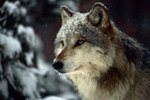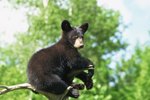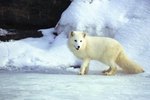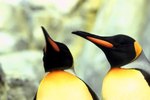
Frigid biomes toward the North and South Poles are forbidding environments. Temperatures plunge well below zero, fresh water and plants are often scarce and in some places the sun doesn't even rise to light and warm the Earth for extended periods. While humans couldn't survive outdoors for long in, say, the Arctic tundra, diverse types of animals have adapted to live there and in other cold climates successfully.
Migration
Some animals live in cold places for part of the year, but migrate to a slightly warmer and more hospitable environment when winter rolls around. Many types of birds, including various species of geese, ducks and cranes, fly south for the winter. Some butterflies, ladybugs and other insects migrate too, as do caribou, white-tailed deer and other mammals. Even lots of fish and whale species swim to warmer waters when the deep chill sets in.
Insulation
Thick fur coats are one way of keeping warm in cold climates, at least for land-dwelling mammals. Polar bears, wolves and musk oxes have thick or double layered coats to help keep warm. Emperor penguins have four layers of overlapping wind- and water-resistant feathers. Then, there's the blubber. Polar bears have lots of body fat, too, since their coats aren't much protection against cold water. Seals, walruses, whales, some penguins and other animals that live some or all of the time in the water are well insulated by blubber.
Coloration
A number of animals in frigid climates let their color work for them. Polar bears have black skin beneath their white fur that absorbs heat from the sun. More common, though, is the white fur itself. Polar bears blend in with the snow to help them sneak up on prey. Hares, foxes, lemmings, ermines, ptarmigans and other animals feature white hair or feathers to help hide them from predators. Many have brownish coats in the spring, though, and only turn white during the snowy season.
Compact Bodies
Animals lose body heat through the surface of the skin. The more surface area an animal has, the more efficiently it loses body heat. Hares and other animals living in cold regions have shorter ears and limbs than their warmer weather counterparts, and many animals have very compact forms to minimize heat loss.
Hibernation
Hibernation is a form of torpor, when an animal enters a state of dormancy and lives off accumulated stores of fat. Hibernating animals sleep through the coldest weather with minimal metabolic activity. Bears are famous hibernators, though most species wake periodically through the winter months to feed. Some ground squirrels, chipmunks and other rodents hibernate for a more prolonged period.
References
- Australian Antarctic Division: Adapting to the Cold
- Michigan State University Extension: Winter Adaptations of Animals
- The University of Texas at Austin Marine Science Institute: Adaptations to the Cold -- How Do Animals and Plants Live in the Arctic?
- National Park Service: Alaskan Animal Adaptations
Photo Credits
-
Tom Brakefield/Stockbyte/Getty Images
Writer Bio
Eric Mohrman has been a freelance writer since 2007, focusing on travel, food and lifestyle stories. His creative writing is also widely published. He lives in Orlando, Florida.




